BUICK CENTURY 1996 Owners Manual
Manufacturer: BUICK, Model Year: 1996, Model line: CENTURY, Model: BUICK CENTURY 1996Pages: 340, PDF Size: 17.61 MB
Page 221 of 340
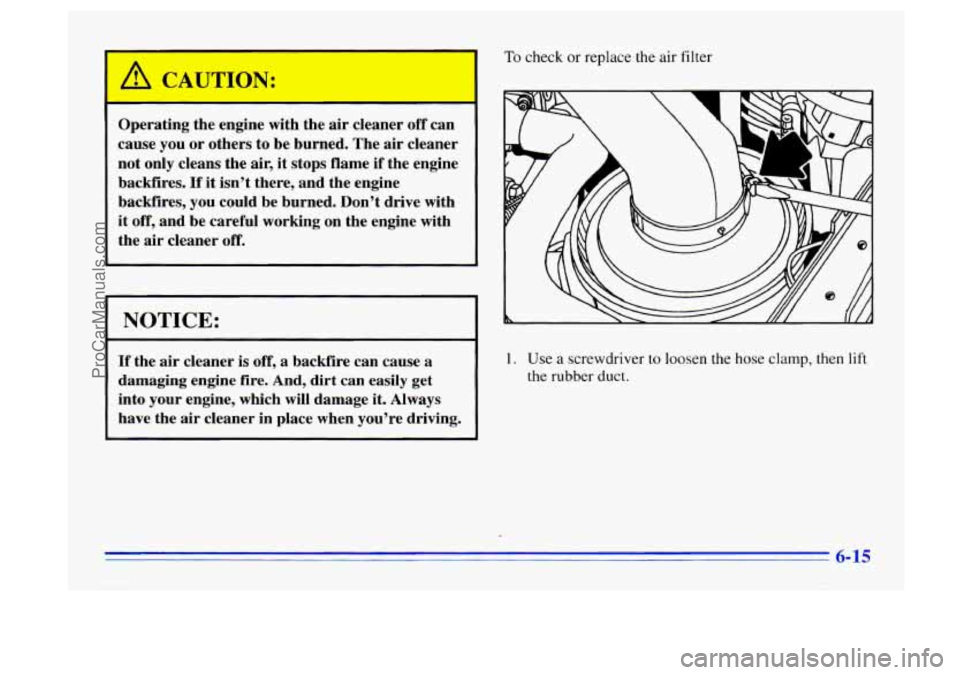
A CAUTION:
I
Operating the engine with the air cleaner off can
cause you or others to be burned. The
air cleaner
not only cleans the
air, it stops flame if the engine
backfires.
If it isn’t there, and the engine
backfires,
you could be burned. Don’t drive with
it off, and be careful working on the engine with
the air cleaner
off.
I
NOTICE:
If the air cleaner is off, a backfire can cause a
damaging engine fire. And, dirt can easily get
into your engine, which will damage it. Always
have the air cleaner in place when you’re driving.
To check or replace the air filter
1. Use a screwdriver to loosen the hose clamp, then lift
the rubber duct.
6-15
ProCarManuals.com
Page 222 of 340
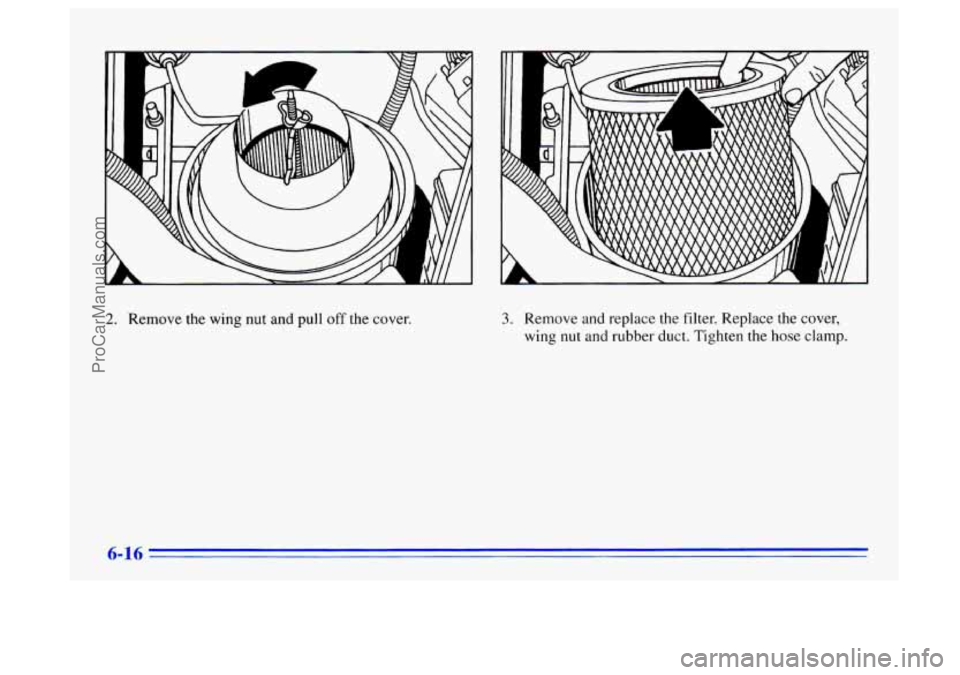
b..
2. Remove the wing nut and pull off the cover. 3. Remove and replace the filter. Replace the cover,
wing
nut and rubber duct. Tighten the hose clamp.
ProCarManuals.com
Page 223 of 340
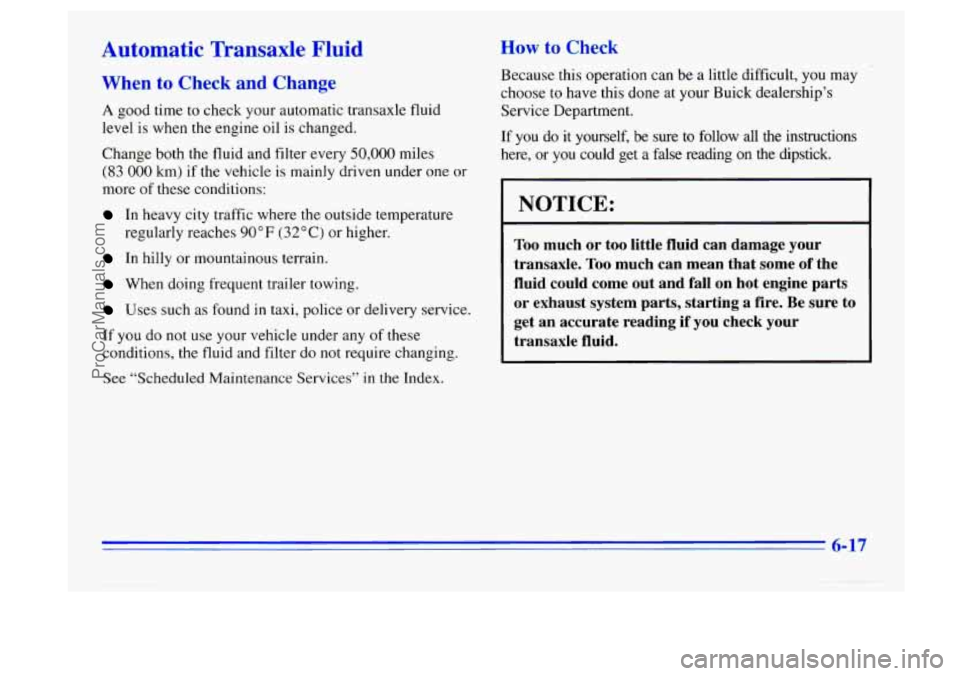
Automatic Transaxle Fluid
A good time to check your automatic transaxle fluid
level
is when the engine oil is changed.
Change both the fluid and filter every
50,000 miles
(83 000 km) if the vehicle is mainly driven under one or
more of these conditions:
In heavy city traffic where the outside temperature
regularly reaches
90” F (32°C) or higher.
In hilly or mountainous terrain.
When doing frequent trailer towing.
Uses such as found in taxi, police or delivery service.
If you do
not use your vehicle under any of these
conditions, the fluid and filter do not require changing.
See “Scheduled Maintenance Services” in the Index.
How to Check
Because this operation can be a little difficult, you may
choose to have this done at your Buick dealership’s
Service Department.
If you do
it yourself, be sure to follow all the instructions
here, or you could get a false reading
on the dipstick.
~~
NOTICE:
Too much or too little fluid can damage your
transaxle.
Too much can mean that some of the
fluid could come out and fall on hot engine parts
or exhaust system parts, starting
a fire. Be sure to
get an accurate reading if you check your
transaxle fluid.
6-17
ProCarManuals.com
Page 224 of 340
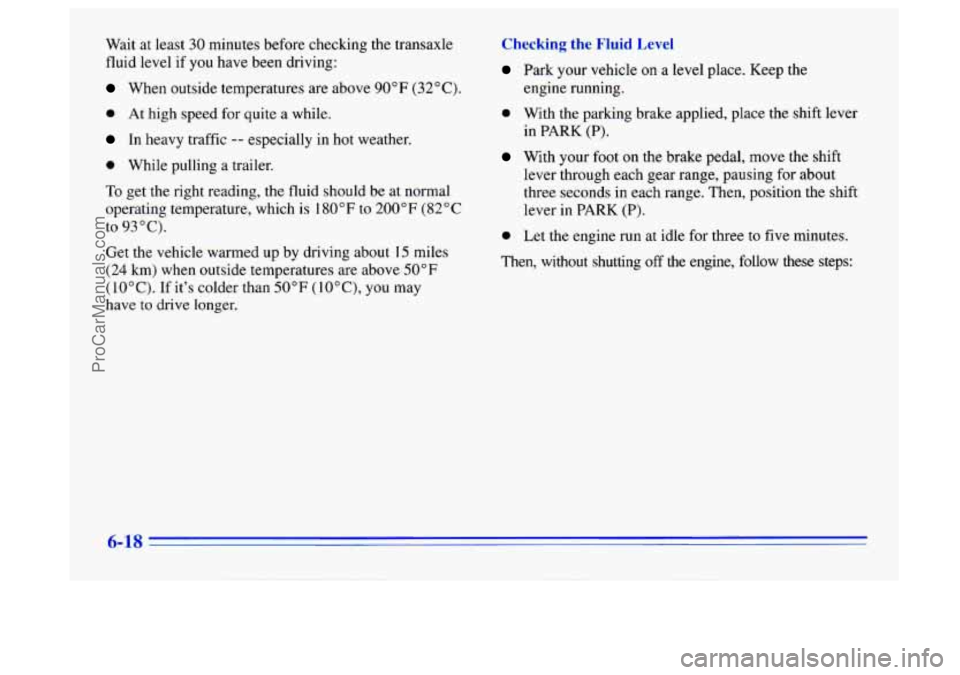
Wait at least 30 minutes before checking the transaxle
fluid level if
you have been driving:
When outside temperatures are above 90 OF (32 O C).
0 At high speed for quite a while.
In heavy traffic -- especially in hot weather.
0 While pulling a trailer.
To get the right reading, the fluid should be at normal
operating temperature, which is
180°F to 200°F (82°C
Get the vehicle warmed up by driving about
15 miles
(24 km) when outside temperatures are above 50°F
(10°C). If it's colder than 50°F (lO"C), you may
have
to drive longer.
to 93°C).
Checking the Fluid Level
Park your vehicle on a level place. Keep the
engine running.
0 With the parking brake applied, place the shift lever
in PARK
(P).
With your foot on the brake pedal, move the shift
lever through each gear range, pausing for about
three seconds
in each range. Then, position the shift
lever in PARK (P).
0 Let the engine run at idle for three to five minutes.
Then, without shutting off the engine, follow these steps:
ProCarManuals.com
Page 225 of 340
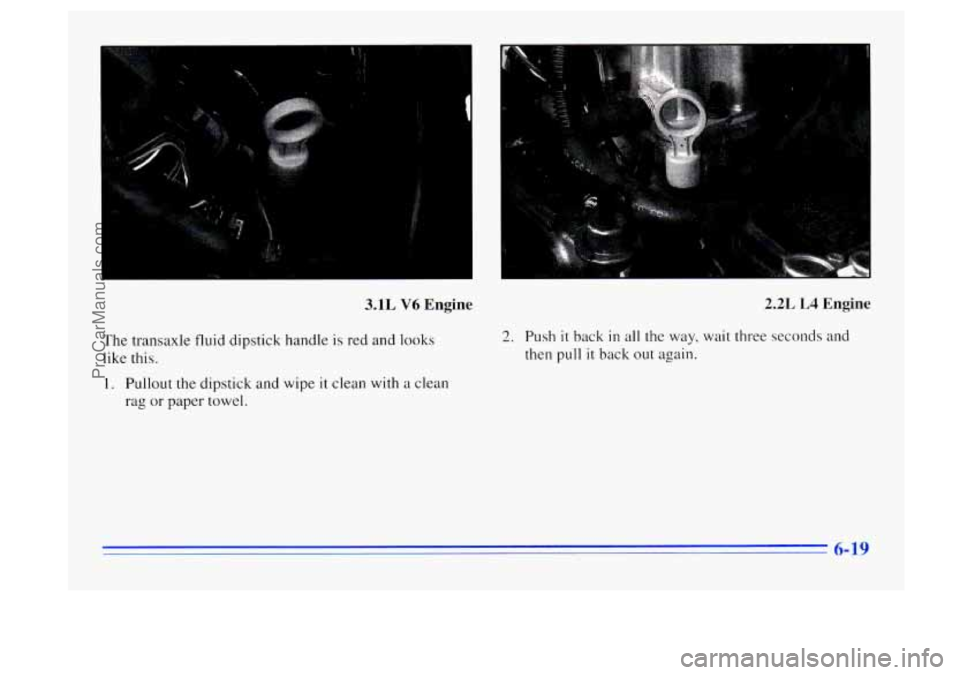
3.1L V6 Engine
The transaxle fluid dipstick handle is red and looks
like this.
1. Pullout the dipstick and wipe it clean with a clean
rag or paper towel.
2.2L L4 Engine
2. Push it back in all the way, wait three seconds and
then pull
it back out again.
6-19
ProCarManuals.com
Page 226 of 340
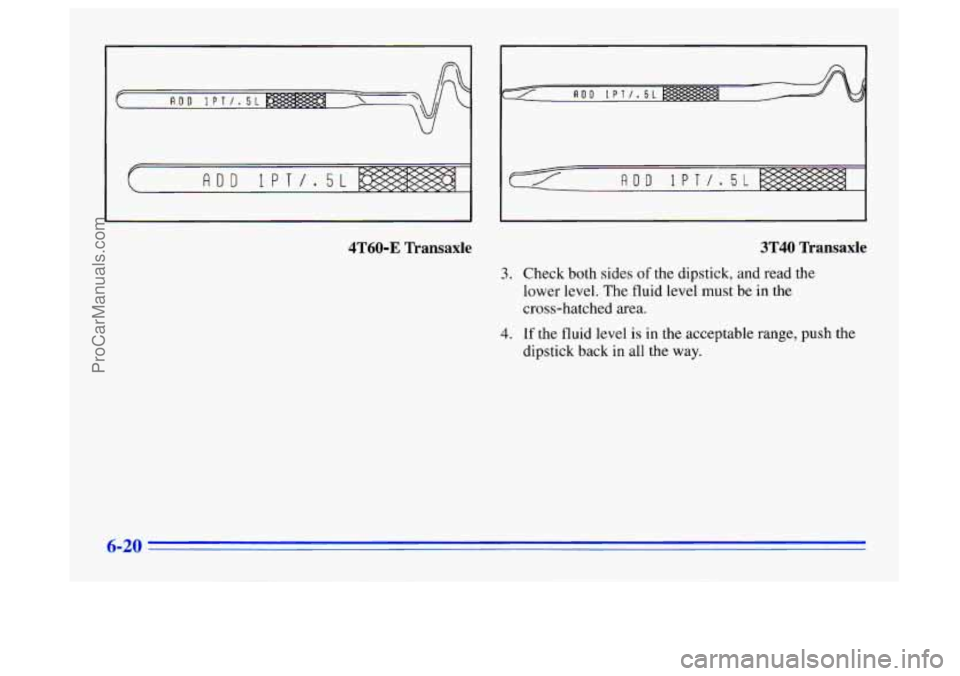
4T60-E Transaxle
3.
4.
3T40 Transaxle
Check both sides of the dipstick, and read the
lower level. The
fluid level must be in the
cross-hatched area.
If the fluid level is in the acceptable range, push the
dipstick back in all the way.
6-20
ProCarManuals.com
Page 227 of 340
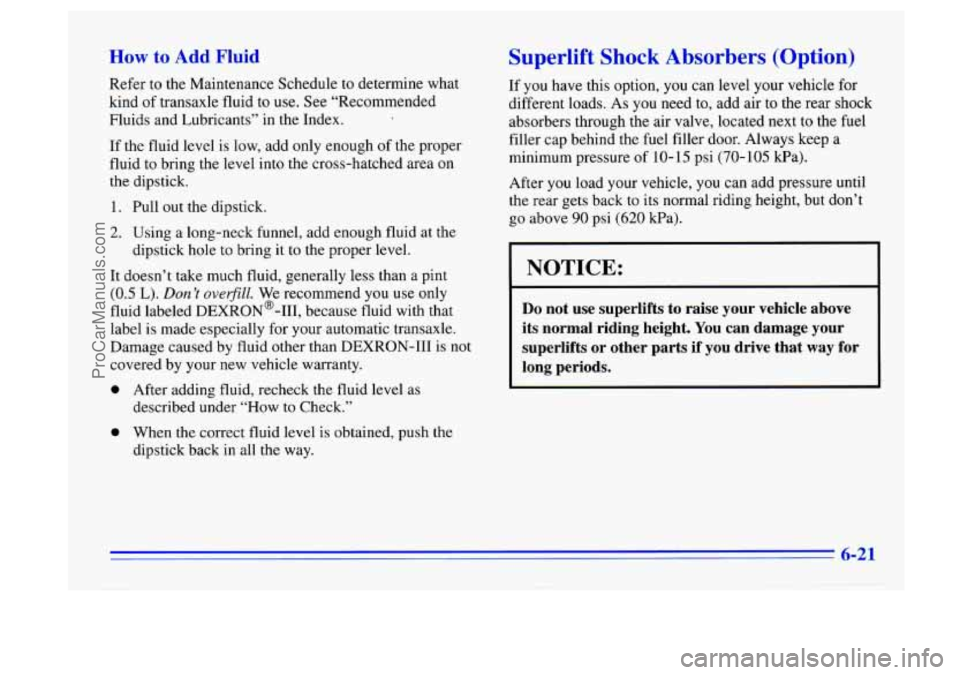
How to Add Fluid
Refer to the Maintenance Schedule to determine what
kind of transaxle fluid to
use. See “Recommended
Fluids and Lubricants” in the Index.
If the fluid level is low, add only enough of the proper
fluid to bring the level into the cross-hatched area
on
the dipstick.
1. Pull out the dipstick.
2. Using a long-neck funnel, add enough fluid at the
It doesn’t take much fluid, generally less than a pint
(0.5
L). Don’t overfiill. We recommend you use only
fluid labeled
DEXRON@-111, because fluid with that
label
is made especially for your automatic transaxle.
Damage caused by fluid other than
DEXRON-I11 is not
covered by your new vehicle warranty.
0 After adding fluid, recheck the fluid level as
dipstick hole
to bring it to the proper level.
described under “How to Check.”
0 When the correct fluid level is obtained, push the
dipstick back in all
the way.
Superlift Shock Absc :rs (Option)
If you have this option, you can level your vehicle for
different loads. As you need to, add air to the rear shock
absorbers through the air valve, located next to the fuel
filler cap behind the fuel filler door. Always keep
a
minimum pressure of 10- 15 psi (70- 105 kPa).
After you load your vehicle, you can add pressure until
the rear gets back to its normal riding height, but don’t
go above 90 psi (620 kPa).
NOTICE:
Do not use superlifts to raise your vehicle above
its normal riding height.
You can damage your
superlifts or other parts if you drive that way for
long periods.
ProCarManuals.com
Page 228 of 340
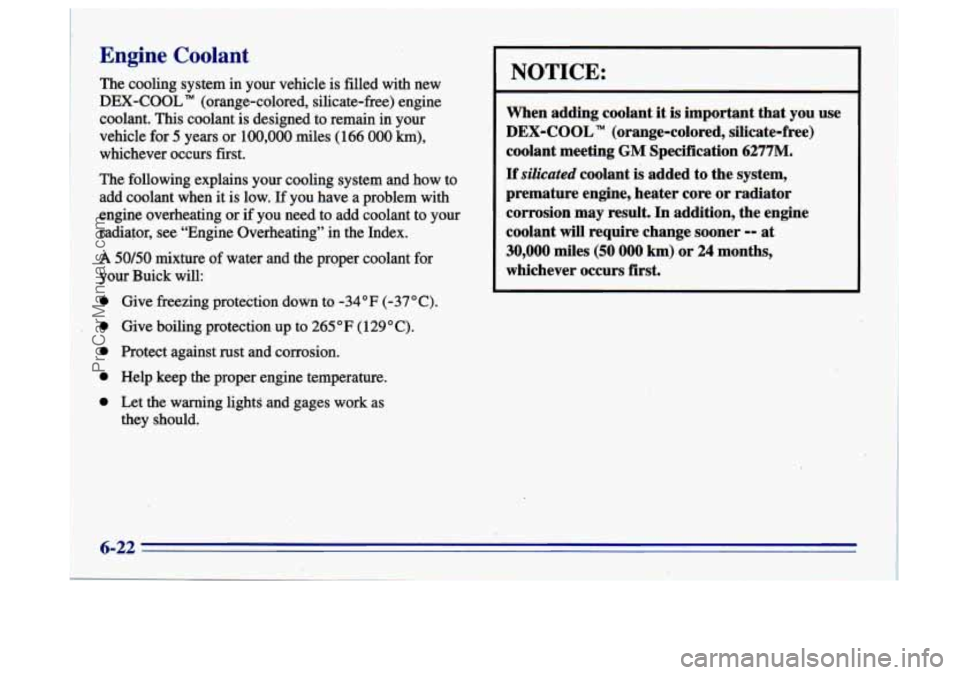
Engine Coolant
@ Protect ag- rust and corrosion.
@ Help.keep the proper engine temperature.
Let the whg lightd md gages work as
they shouicl.
NOTICE:
When adding coolant it is important that you use
DEX-COOL TM (orange-colored, silicate-free)
coolant meeting
GM Specification 6277M.
If silicated coolant is added to the system,
premature engine, heater core or radiator
corrosion may result. In addition, the engiue
coolant will
require change sooner -- at
30,000 miles (50 000 km) or 24 months,
whichever occurs first.
ProCarManuals.com
Page 229 of 340
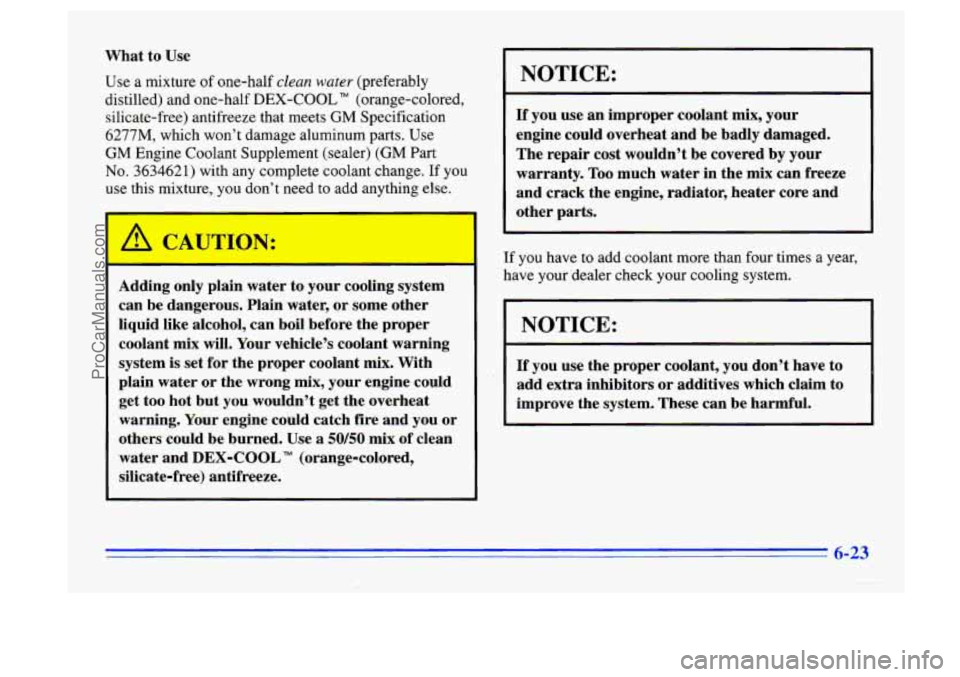
What to Use
Use a mixture of one-half clean water (preferably
distilled) and one-half
DEX-COOL TM (orange-colored,
silicate-free) antifreeze that meets
GM Specification
6277M, which won’t damage aluminum parts. Use
GM Engine Coolant Supplement (sealer) (GM Part
No. 3634621) with any complete coolant change. If you
use this mixture, you don’t need to add anything else.
lain water to your cooling system
can be dangerous. Plain water, or some other
liquid like alcohol, can boil before the proper
coolant mix will. Your vehicle’s coolant warning
system is set for the proper coolant mix. With
plain water or the wrong mix, your engine could
get too hot but you wouldn’t get the overheat
warning.
Your engine could catch fire and you or
others could be burned. Use
a 50/50 mix of clean
water and
DEX-COOL TM (orange-colored,
silicate-free) antifreeze.
I NOTICE:
If you use an improper coolant mix, your
engine could overheat and be badly damaged.
The repair cost wouldn’t be covered by your
warranty. Too much water in the mix can freeze
and crack the engine, radiator, heater core and
other parts.
If you have to add coolant more than four times a year,
have your dealer check your cooling system.
NOTICE:
If you use the proper coolant, you don’t have to
add extra inhibitors or additives which claim to
improve the system. These can be harmful.
6-23
ProCarManuals.com
Page 230 of 340
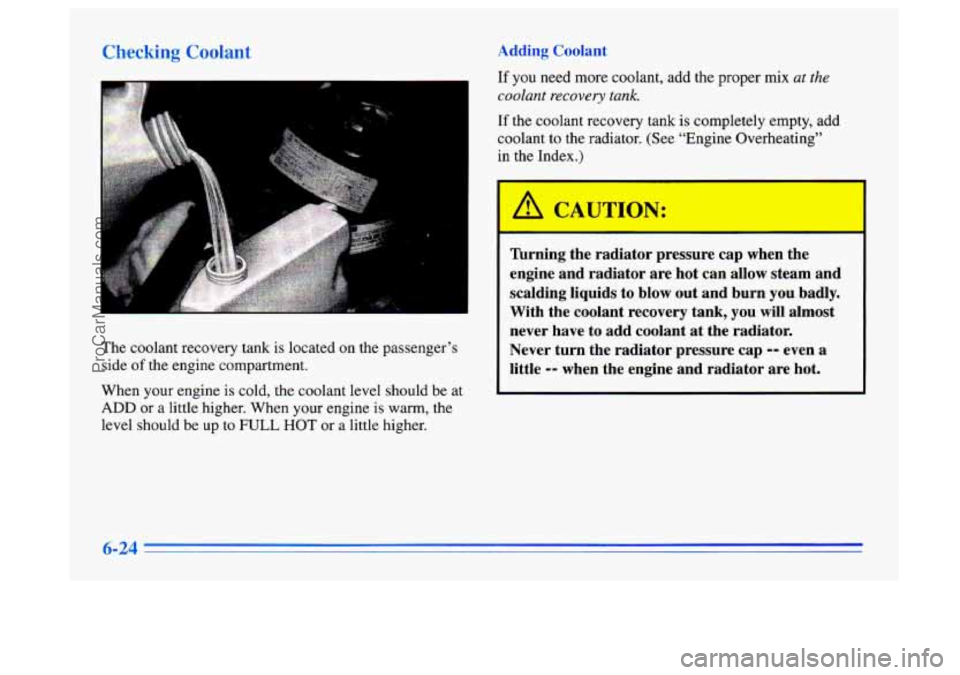
rhacking Coc’mt * clding Coolant
!
The coolant recovery tank is located on the passenger’s
side
of the engine compartment.
When your engine is cold, the coolant level should be at
ADD or a little higher. When your engine is warm, the
level should be up to
FULL HOT or a little higher.
.
If you need more coolant, add the proper mix at the
coolant recovery tank.
If the coolant recovery tank is completely empty, add
coolant to the radiator. (See “Engine Overheating”
in the Index.)
I-
Thrning the radiator pressure cap when the
engine and radiator are hot can allow steam and
scalding liquids to blow out and burn you badly.
With the coolant recovery tank, you
will almost
never have to add coolant at the radiator.
Never turn the radiator pressure
cap -- even a
little
-- when the engine and radiator are hot.
ProCarManuals.com